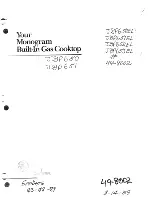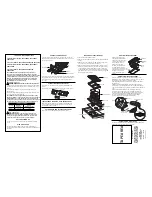
26
Instructions for assembly
GB
Instructions for assembly
Safety instructions for kitchen unit fitters
• Veneers, adhesives and plastic surfaces of surrounding
furniture must be temperature resistant (at least 75°C). If the
veneers and surfaces are not sufficiently heat resistant they
may become deformed.
• Ensure that all live connections are safely insulated when
installing the hob.
• Cover strips between the wall and the worktop behind the hob
which are made of solid wood are permissible as long as
minimum clearances in accordance with the installation
diagrams are maintained.
• Minimum clearances of the hob cut-out towards the rear are to
be maintained in accordance with the installation diagram.
• For installation directly next to a tall cupboard, a safety
distance of at least 50 mm must be ensured. The side surface
of the tall cupboard should be fitted with heat resistant
material. Due to working requirements, however, the distance
should be at least 300 mm.
• The clearance between the hob and an extraction hood must
be at least as large as that stipulated in the assembly
instructions for the cooker hood.
• The packaging materials (plastic foil, polystyrene, nails etc.)
must be kept out of reach of children as these parts are
potentially dangerous. Small parts can be swallowed and there
is a danger of plastic sheeting causing suffocation.
Ventilation
• Clearance between the induction hob and kitchen furniture or
built-in units must provide for sufficient ventilation of the
induction hob.
• If the power level of a cooking zone is automatically raised or
lowered (see section on thermal cut-off device) it is likely that
the cooling system does not cool sufficiently.
• The back wall of the bottom cabinet must be open in the area
of the cut-out in order to provide for air circulation.
• The front transverse strip of the unit must be removed so that
an opening is provided for air flow underneath the worktop
over the entire width of the appliance.
• Remove any transverse strips underneath the worktop at least
in the area of the worktop cut-out.
Installation
Important information
• Avoid excessive thermal development from below e.g. from a
baking oven without a cross flow cooling device.
• The induction hob may not be used when pyrolysis operation
is taking place in a built-in oven.
• When installing the appliance on top of a drawer it is essential
to ensure that no sharp items are stored in the drawer since
these could become bent on the underside of the hob and
prevent the drawer from being opened and closed.
• If a shelf has been inserted underneath the hob, there must be
a clearance of at least 20 mm to the underside of the hob in
order to ensure that the hob is sufficiently ventilated.
• The hob may not be installed above refrigerators, freezers,
dishwashers, washing machines or dryers.
• To avoid danger of fire, make sure that no combustible objects
which could easily catch fire or become deformed on exposure
to heat are directly next to or under the surface.
Sealing of the hob
Before installation, correctly insert the sealing unit delivered with
the hob.
• No liquids may penetrate between the edge of the hob and the
worktop or between the hob and the wall and come into
contact with any electrical appliances.
• When installing a hob into an uneven worktop, e.g. with a
ceramic or similar covering (tiles etc.), the seal on the hob is to
be removed and the seal between the hob and worktop made
with plastic sealing materials (putty).
•
The hob must under no circumstances be sealed with
silicone sealant!
This would make it impossible to remove the
hob at a later date without damaging it.
Working surface cut-out
Cut out the worktop recess accurately with a good, straight saw
blade or recessing machine. The cut edges should then be
sealed so that no moisture can penetrate.
The area is cut out as illustrated. The glass ceramic hob must
have a level and flush bearing. Any distortion may lead to
fracture of the glass panel. Make sure that the sealing of the hob
is properly seated.
The glass ceramic hob is fastened with clips or with brackets.
















































